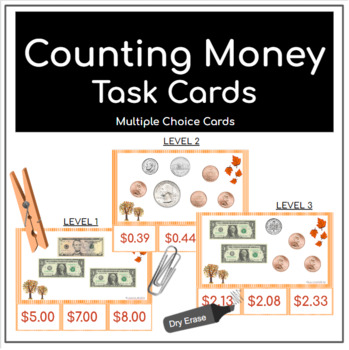Counting U.S. Money Task Cards - 3 Levels
Lifetime Learning Lodge
63 Followers
Grade Levels
1st - 12th
Subjects
Resource Type
Standards
CCSS2.MD.C.8
CCSS1.NBT.C.4
CCSS1.OA.C.6
Formats Included
- PDF
Pages
14 pages
Lifetime Learning Lodge
63 Followers
Also included in
- Looking to build your Math station / center resources? Bundle the time and money task cards and save! Bundle Includes 6 decks of task cards at multiple levels.Check out the resources for more information on the products and how to use them.Price $3.00Original Price $4.00Save $1.00
Description
3 Levels / 3 Sets of Cards to practice Counting U.S. Money
Level 1 Deck:
- Includes 16 cards
- Counting U.S. mixed U.S. bills
- Multiple Choice
Level 2 Deck:
- Includes 16 cards
- Counting U.S. mixed coins
- Multiple Choice
Level 3 Deck:
- Includes 16 cards
- Counting mixed U.S. bills and coins
- Multiple Choice
Recommended Use:
- Print, Laminate and Cut out the cards.
- Use paper clips, clothespins, or dry erase markers for students to mark their answer with.
- Check their work, record data, and use again and again!
This product is great for independent practice, math centers/stations, and special education data tracking and stations/centers. Prep the materials once and reuse again and again, school year after school year.
This is a great and timeless resource to add to your classroom resources.
Total Pages
14 pages
Answer Key
N/A
Teaching Duration
N/A
Report this resource to TPT
Reported resources will be reviewed by our team. Report this resource to let us know if this resource violates TPT’s content guidelines.
Standards
to see state-specific standards (only available in the US).
CCSS2.MD.C.8
Solve word problems involving dollar bills, quarters, dimes, nickels, and pennies, using $ and ¢ symbols appropriately. Example: If you have 2 dimes and 3 pennies, how many cents do you have?
CCSS1.NBT.C.4
Add within 100, including adding a two-digit number and a one-digit number, and adding a two-digit number and a multiple of 10, using concrete models or drawings and strategies based on place value, properties of operations, and/or the relationship between addition and subtraction; relate the strategy to a written method and explain the reasoning used. Understand that in adding two-digit numbers, one adds tens and tens, ones and ones; and sometimes it is necessary to compose a ten.
CCSS1.OA.C.6
Add and subtract within 20, demonstrating fluency for addition and subtraction within 10. Use strategies such as counting on; making ten (e.g., 8 + 6 = 8 + 2 + 4 = 10 + 4 = 14); decomposing a number leading to a ten (e.g., 13 - 4 = 13 - 3 - 1 = 10 - 1 = 9); using the relationship between addition and subtraction (e.g., knowing that 8 + 4 = 12, one knows 12 - 8 = 4); and creating equivalent but easier or known sums (e.g., adding 6 + 7 by creating the known equivalent 6 + 6 + 1 = 12 + 1 = 13).






